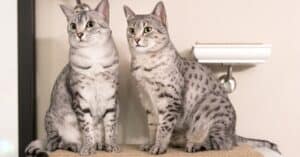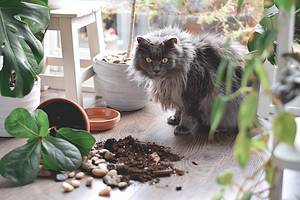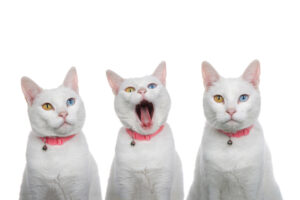Cats are soft, furry balls of love! But did you know that several types of hairless cats are just as lovable? In fact, many people who suffer from cat allergies may find that a hairless cat is just what they need.
Of course, no pet is fully hypoallergenic since they still produce dander. However, someone with allergies may have a better shot at staying healthy and sniffle-free with a hairless cat since there’s no hair for dander to cling to. After learning more about these unique felines, you might want to become the proud guardian of a fur-less creature. Besides, bald is beautiful!
Let’s jump right into getting to know these other-worldly felines.
1. Sphynx
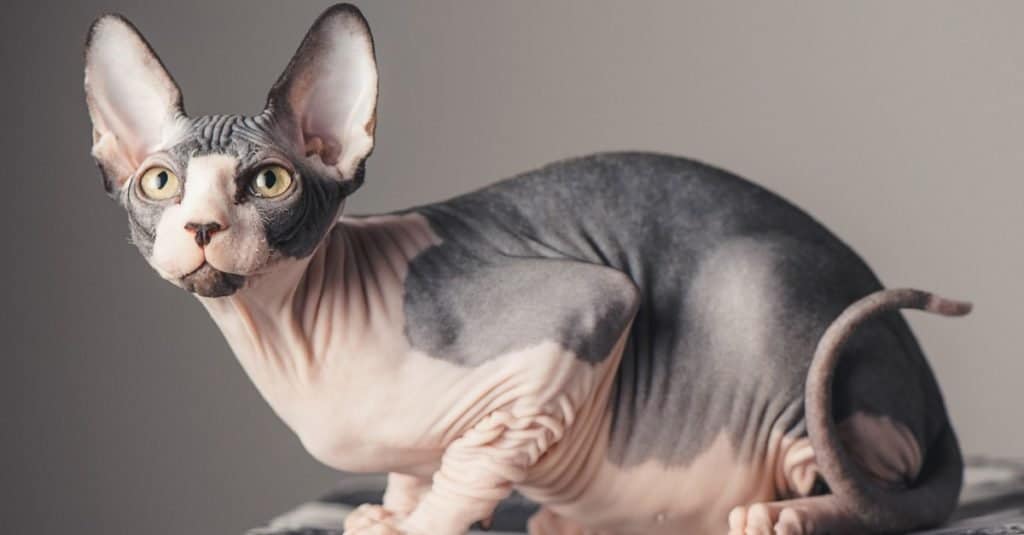
The Sphynx cat is known for being clingy. They love to cuddle and are equally sensitive and sweet.
©Yuryi Oleinikov/Shutterstock.com
Personality: This feline wonder is the most recognizable type of hairless cats. As strange as they may appear, Sphynx cats are some of the most personable felines that exist and are definitely a bunch of wrinkles you won’t want to get rid of. These cats are more than happy to give you plenty of lap time. You’ll find them loving on family members as much as possible.
History: In 1966, a domestic shorthair cat in Ontario, Canada, gave birth to a tiny hairless kitten, a little boy they named Prune. Prune was born without any hair due to a naturally occurring genetic mutation. Breeders wanted to see if they could produce more hairless cats from Prune’s line; thus, the Canadian Sphynx was born.
Skin condition: If you think no hair, little care, you’ll need to hear the facts first. These cats have soft “fuzz” on their bodies, but it can be hard to see or even feel. There is usually some very soft hair on their ears, nose, tail, and feet. However, since they’re mostly hairless, their skin needs extra protection to ward off sunburn and cold temperatures (time to break out the cute kitty sweaters!).
Their skin is also oily, so they need frequent baths – but take care not to give them too many. It’s a delicate balance, as you do not want to dry out their skin. Consult with your vet to figure out the best strategy.
Interesting Facts: Contrary to popular belief, the Sphynx isn’t hypoallergenic since these cats still produce dander. However, they are better for someone with allergies than a long-haired cat, as the dander does not get trapped or collect in layers of fur.
2. Peterbald
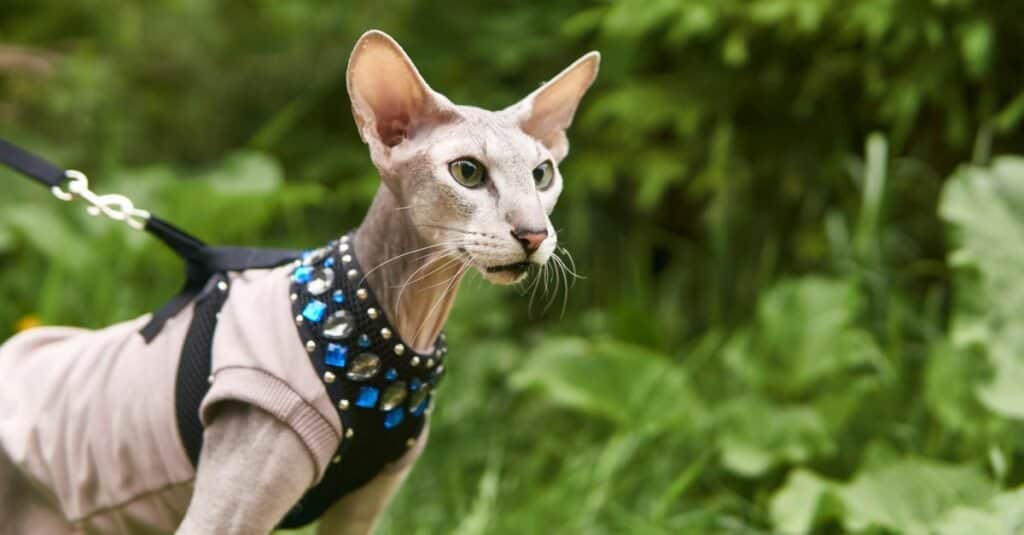
The Peterbald’s gene for baldness is dominant, so crossbreeding can produce hairless kittens.
©iStock.com/Евгений Харитонов
Personality: This Russian beauty is extremely intelligent, curious, and friendly. Peterbald cats have long legs, almond-shaped eyes, large ears, and a thin tail like a whip. They are sweet cats that get along with cats, dogs, and children. They’re loving, affectionate, and loyal, so if you’re looking for someone in your fan club, the Peterbald is the perfect candidate. These cats are certainly not loners and don’t enjoy being left alone for long periods – and they will be sure to let you know, as they are also quite vocal.
History: Developed in Russia in the late 1980s, the Peterbald cat breed was accepted by The International Cat Association in 1997 and the World Cat Federation in 2003.
Skin condition: Some Peterbald cats are completely hairless, while others have a peach-like fuzz, extremely short and wiry hair, or even a normal fur coat. These beauties need regular baths; otherwise, they’ll have excess oil on the skin, which attracts dirt and can make it feel sticky. However, talk to your vet about the frequency of bathing them because every cat is different.
Interesting Facts: A rare breed, the Peterbald is especially sought after. They love to “talk,” too, so be prepared for a vocal kitty.
3. Minskin
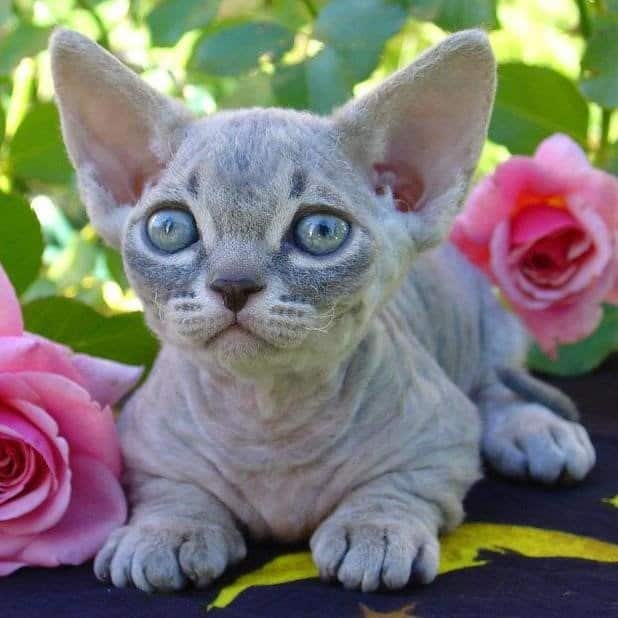
The Minskin breed is a true Millennial cat, first appearing in Boston in 2000.
©By Paulmcsorley https://commons.wikimedia.org/w/index.php?curid=26572384 – License
Personality: The minskin is a cute and curious-looking cat with short legs and little to no hair. This hairless cat proudly sports different colors and patterns, so there’s plenty of variety to choose from. These felines are friendly, affectionate, and intelligent. They are also wonderful with kids, dogs, and other cats.
History: What do you get when you cross a munchkin cat, a Sphynx, and just a sprinkle of a Devon Rex and a Burmese? A minskin! Breeder Paul McSorley began the development of these little sweethearts in 1998 in Boston. It was accepted as a Preliminary New Breed (PNB) in 2008 by The International Cat Association.
Skin condition: As with many hairless breeds, their fur-free skin is susceptible to sunburn. They also need to be sheltered from cold temperatures.
Interesting Facts: Breeding the minskin (along with other munchkin hybrids) is highly controversial. For example, as International Cat Care explains:
“Cats (Felis catus) are not a species with naturally short legs. Mutations that cause short legs may be detrimental in restricting aspects of the cat’s mobility and in some cases leg deformities may be painful and debilitating through the development of abnormal joints.”
4. Bambino
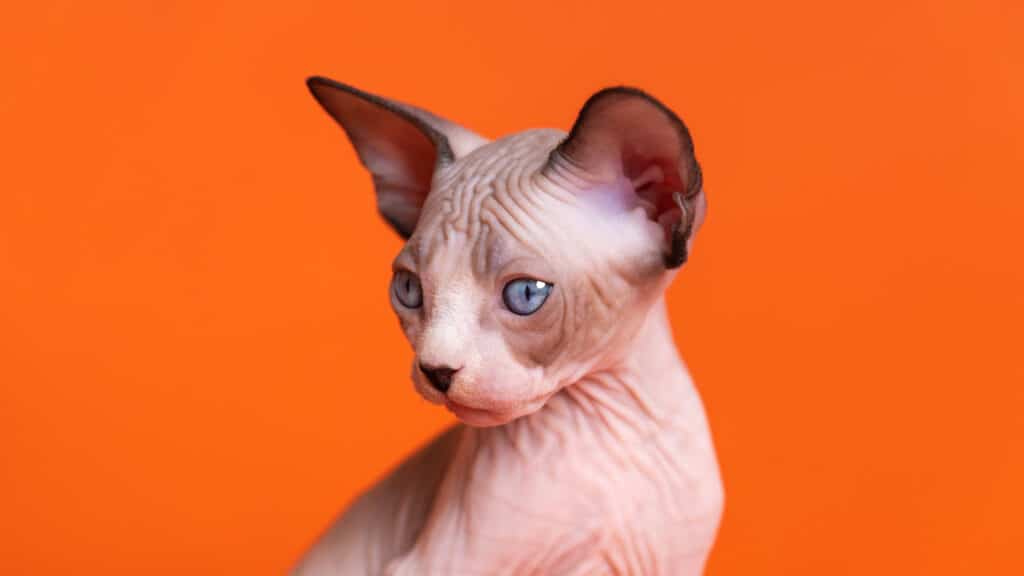
A Bambino is a hairless cat that looks like a Sphynx but with much shorter legs and a smaller body.
©iStock.com/geyzer
Personality: Another munchkin hybrid, the bambino, is a small but fiercely affectionate lap cat with very short legs. Some bambinos even have a hairy tail that makes them look like a small hairless lion! Bambino cats usually do not grow bigger than nine pounds and are energetic and playful cats. They do not like to be left alone for very long and can get depressed easily. However, bambinos are loving cats that are quick to shower affection on their human families.
History: Pat and Stephanie Osborne introduced bambino cats to the world in 2005. They owned a cattery in Arkansas. They bred Sphynx cats with a recessive hairless gene with munchkin cats. Bambinos were accepted in 2005 by The International Cat Association as an experimental breed. However, both the American Cat Fanciers’ Association and the Cat Fanciers’ Association refused to accept the bambino breed’s registry as they did not want to encourage the breeding of genetic abnormalities.
Skin condition: Bald and beautiful, bambino cats usually have a very thin and fine layer of downy fur that makes their skin feel like soft suede. These cats require regular bathing to protect their skin from dirt, oils, sebaceous secretions, and other skin conditions.
Interesting Facts: The bambino cat gets its name from the Italian word “bambino,” which means baby. Not only are these hairless cuties small, but their diminutive features make them look like kittens.
5. Ukrainian Levkoy
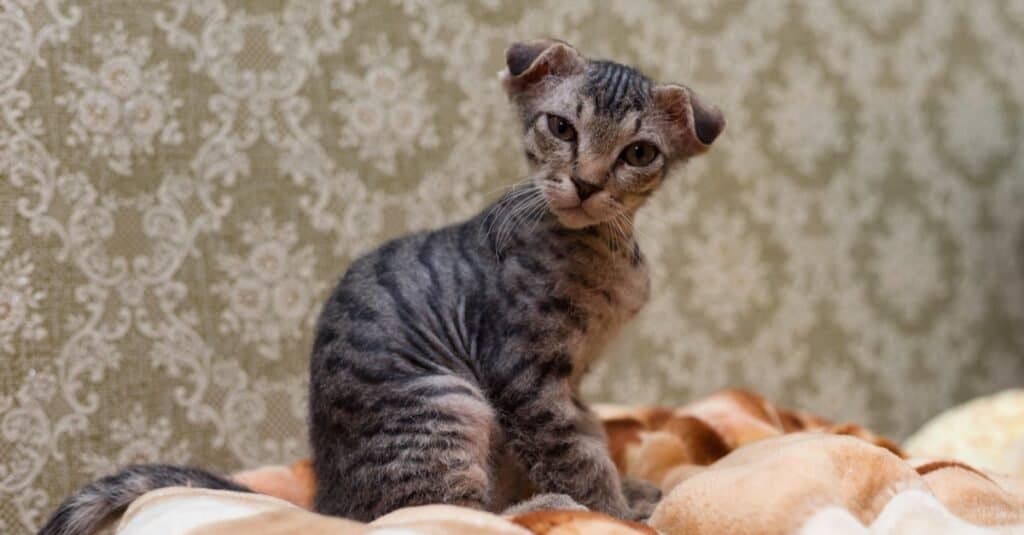
The Ukrainian Levkoy is highly affectionate with a laid-back, playful temperament.
©Ravelios/Shutterstock.com
Personality: A regal and sophisticated-looking type of hairless cat, the Ukrainian Levkoy has a slender yet muscular body and soft skin. These cats are playful, curious, sociable, and intelligent. They quickly hit it off with other pets, and they’ll even welcome strangers with open arms. They’re also quite vocal, so be prepared to hear their opinions. These rare cats can get anxious and will stress if they are left alone for too long. However, they can be appeased with another feline friend. Ukrainian Levkoys require lots of love and attention, but they will reward you with endless cuteness and lots of cuddling.
History: Developed between 2000-2011 by Russian breeder Elena Vsevolodovna Birjukova, Ukrainian Levokys are the result of crossing Scottish fold cats with Donskoy cats. As a new and fairly recent breed, the Ukrainian Levkoy is not currently recognized by the international cat breed associations, but Russian and Ukrainian clubs accept it.
Skin condition: These cats have elastic, wrinkly skin that, like some of their counterparts, may be prone to yeast infections. Many also do have a thin coat of soft and downy fur.
Interesting Facts: Their ears fold over towards the face like some dogs. This is actually where the cats get their name from since their folded ears look like the folded leaves of the Levkoy plant. It gives them a true one-of-a-kind appearance in the world of hairless cats.
6. Donskoy
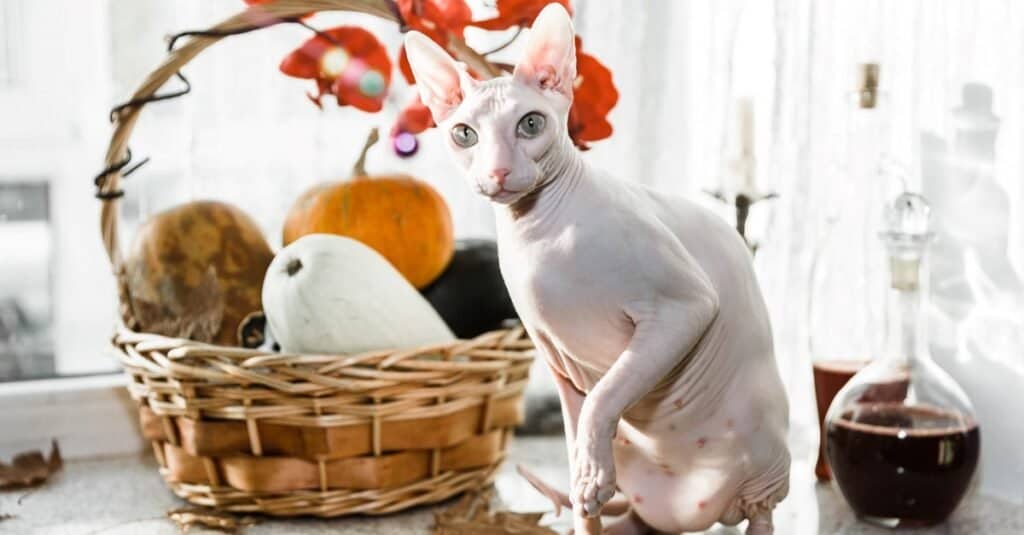
Donskoy cats are great pets for people with allergies, as they shed little to no hair or dander.
©kapichka/Shutterstock.com
Personality: This Russian cat breed makes an excellent companion, especially if you are looking for a cat that loves cuddling. Donskoy cats are loyal felines that are notably friendly. They’re also affectionate, playful, gentle with kids and other pets, and highly trainable to follow voice commands. However, these sweet kitties also have a curious streak and love to climb, open cupboards, and investigate boxes and bags.
History: Elena Kovalena, a professor in Russia, rescued a partially hairless kitten that a group of boys had tortured. The kitten eventually had a litter of her own, complete with both furry and furless kittens. One of these hairless kittens was adopted by Irinia Nemikina, a professional breeder who helped to create the Donskoy cat breed, another type of hairless cat. They are also known as Don Sphynx cats and Russian hairless cats.
Skin condition: As with other hairless cats, using wipes (specifically made for pets) to clean these cats between baths gently is better for them than over-bathing since that can be taxing to their skin.
Interesting Facts: The hairless nature of this cat comes from a dominant mutation in its genes. Some of the breed’s kittens are born hairless, while some lose their hair as they grow. Donskoy cats grow a bit more hair to keep them warm in the winter but lose it once it warms up again. They’re also prone to tooth decay and gum disease, so be sure to brush up on toothbrushing for cats.
7. Elf Cat
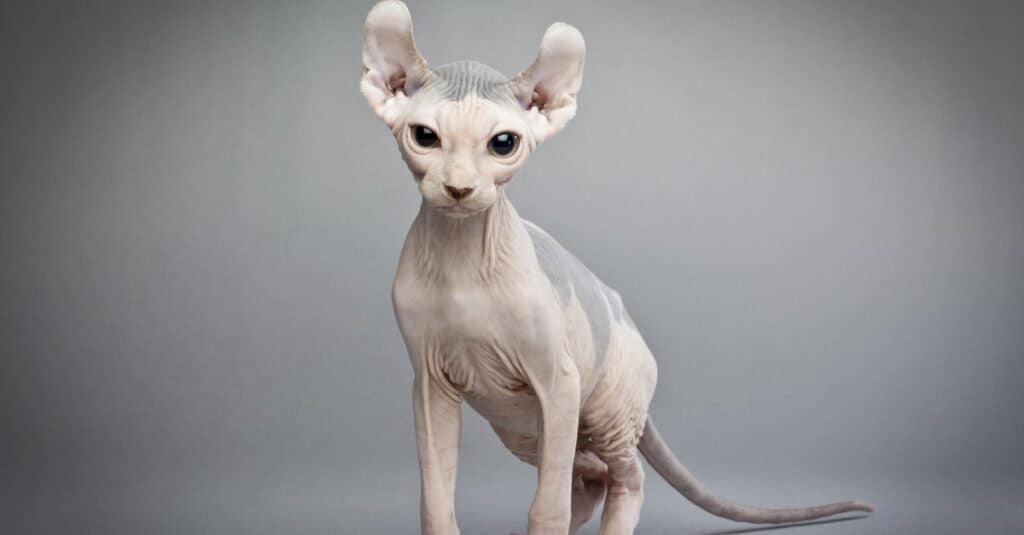
A new and rare breed, the elf is a hairless cat with unique curled ears. They are affectionate and playful.
©Dan Kosmayer/Shutterstock.com
Personality: The elf cat is a rather new breed in the cat world. This hybrid is a bright-eyed and intelligent cat and needs stimulating environments to keep them entertained. Elf cats are new to the scene, but so far, owners report that they love to play and soak up as much attention as possible. They are adorable little extroverts that are kid-friendly, pet-friendly, affectionate, and playful. What’s not to love?
History: Two breeders and cat lovers, Karen Nelson and Kristen Leedom are responsible for developing the elf cat breed. They crossbred the Sphynx with the American curl in 2004 in the hopes of producing a type of hairless cat that had the signature curled ears as well as the physical elegance of a Sphynx.
Skin condition: Their skin is covered by fur that is so fine it can be tricky to see. Much like a Sphynx cat, elf cats need a balanced bathing regimen.
Interesting Facts: Their ears grow straight up, and the tips curl slightly backward, making it look like they could start flapping them at any moment to take off for flight.
8. Dwelf Cat
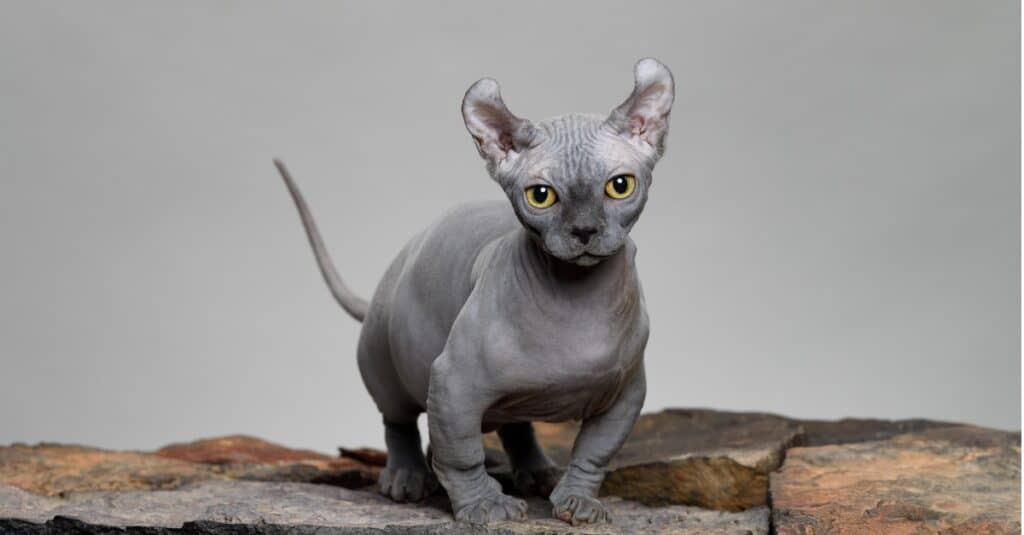
The dwelf cat may just be the strangest of the tiniest cats.
©iStock.com/Thomas Leirikh
Personality: These frisky “players” love to be with their families. They’re well-known for being extremely playful, and many owners report that they act like miniature dogs. They’re friendly, love to cuddle, and don’t sit on the sidelines. So, they need lots of mental stimulation and playtime. These cats are affectionate and want to be involved in your life. Dwelf cats love being around people, so be sure not to leave them alone for long periods.
History: A dwelf was developed by crossing a munchkin, a Sphynx, and an American curl. It sounds far out, but that’s exactly what happened when this type of hairless cat was “Made in America” in the mid-2000s. The result is an adorably small, hairless cat with curled ears. Dwelf cats generally don’t weigh more than five pounds!
Skin condition: They’re covered in a light fuzz and are quite sensitive to hot and cold temperatures, so keeping your indoor environment just right will be your goal.
Interesting: These cats have a lot of energy, are extremely playful, and are highly intelligent. You might need to lock your cabinets with one of these little kitties around.
9. Lykoi
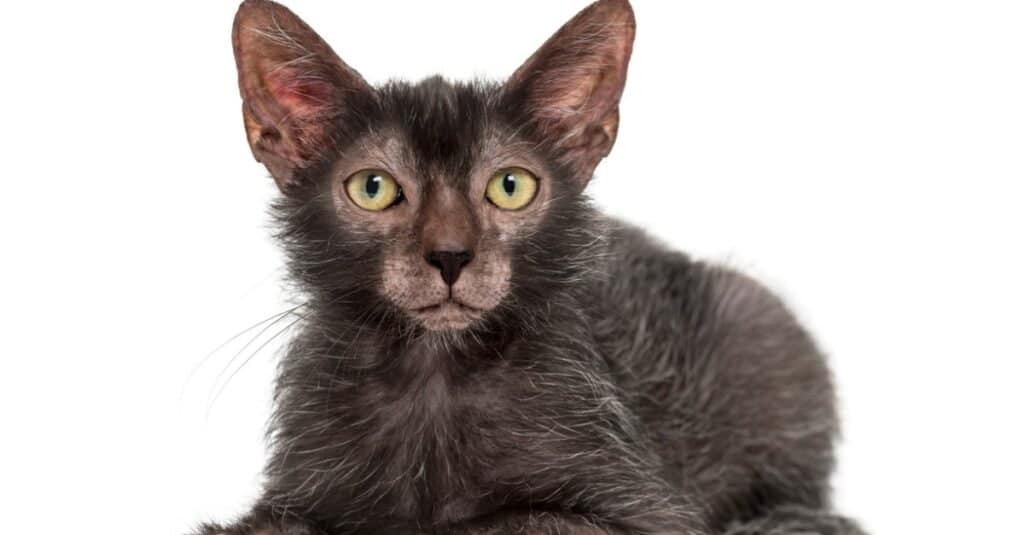
Despite their feral appearance, Lykoi cats are friendly, affectionate, and playful.
©iStock.com/GlobalP
Personality: The lykoi cat breed is a rather unique type of hairless cat since they often do have hair. Some cats can be full-out furballs with shorthair coats, while others are partially hairless. They shed periodically, so even a hairy lykoi cat can be completely hairless for a season. When they shed, they can lose whole patches at a time, particularly around the face, making them look like goofy yet adorable miniature werewolves. Lykoi cats may look a bit frightening, but these cats are anything but scary! With fun-loving personalities and friendly demeanors, these intelligent cats enjoy interacting with other cats, humans, and even dogs.
History: Strangely enough, although the lykoi breed is pretty new in the cat world, its unique appearance was not a “man-made” feature. It’s actually a natural mutation found in rare and random cases in feral cats. In 2010 the mutation was discovered in a U.S. feral cat colony, and the cats were bred intentionally to produce more of these “wolf-faced” felines. Over the years, more mutations in feral cats around the world have been reported, which helps to add more diversity to the gene pool and pedigrees of the lykoi breed.
Skin condition: Like many other hairless breeds, lykoi cats must be washed regularly. However, bathing is pretty simple since they don’t have much hair.
Interesting Facts: When lykoi cats shed, the hair (or lack thereof) around their faces makes them look like a werewolf. Their name comes from the Greek word “lycos,” which means wolf.
Caring for a Hairless Cat
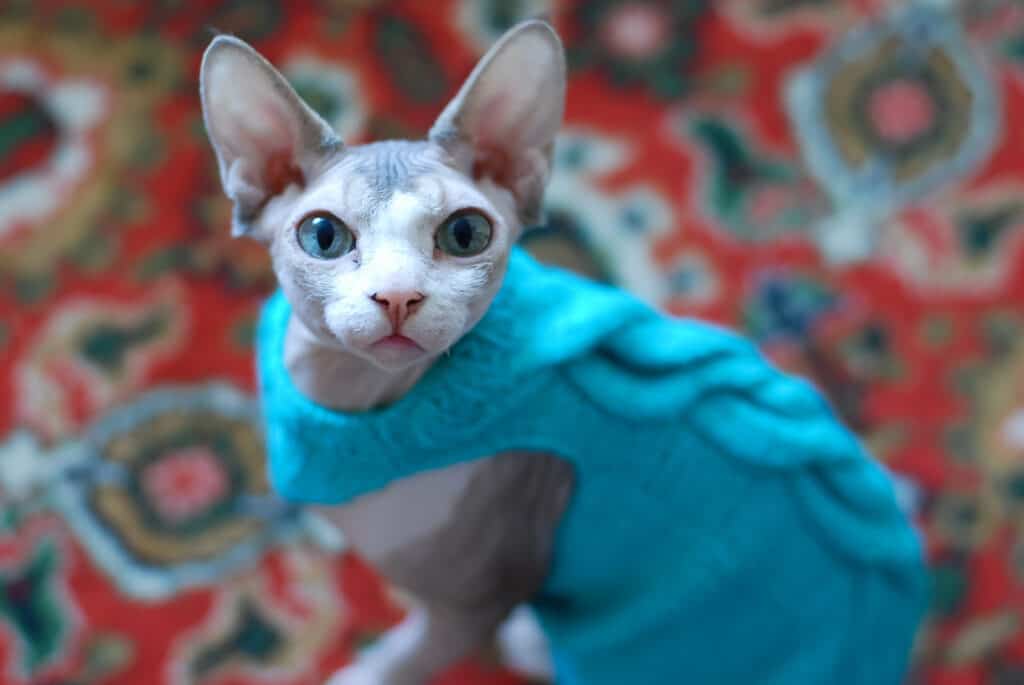
Types of hairless cat breeds are sensitive to the cold and need plenty of sweaters to keep them warm.
©iStock.com/OlgaChan
It might seem counter-intuitive, but a hairless cat can require a little more care than a big fluffy feline. The hair on a furry cat helps to absorb oils produced by its skin, which is why they do not need to be bathed often. On the other hand, hairless cats do not have this extra help for their skin oils, which is why they need regular baths. However, be sure to use shampoos specifically made for cats since their skin is sensitive.
All hairless cats need to live indoors due to their delicate skin. Being exposed to the elements could have devastating effects. If you take your cat outside or if they enjoy sunbathing even while indoors (as cats love to do), be sure to get some feline sunscreen (made specifically for cats) to protect their delicate skin, and dress them in a shirt or jacket. You certainly don’t want your sweet bald baby to get sunburned in the safety of their own home!
Be sure your cat has a soft sweater to wear when it’s cold and plenty of warm places to snuggle. Kitty clothes can also protect them from inadvertently being scratched by a roommate. Being hairless, their skin is vulnerable to just about everything, so it needs some protective armor.
Lastly, our hairless feline friends have fast metabolisms, so they may be bigger eaters than other cat breeds. Be sure to keep that in mind when you’re preparing dinner, as hairless breeds can be prone to obesity if not monitored.
The photo featured at the top of this post is © iStock.com/OlgaChan
Sources
- INTERNATIONAL CAT CARE, Available here: https://icatcare.org/advice/munchkin/
- The Cat Fanciers’ Association, Available here: https://cfa.org/lykoi/
- Rare and Exotic Feline Registry, Available here: https://www.rareexoticfelineregistry.com/elf-cat/
- The Cat Fanciers’ Association, Available here: https://cfa.org/sphynx/
Thank you for reading! Have some feedback for us? Contact the AZ Animals editorial team.



